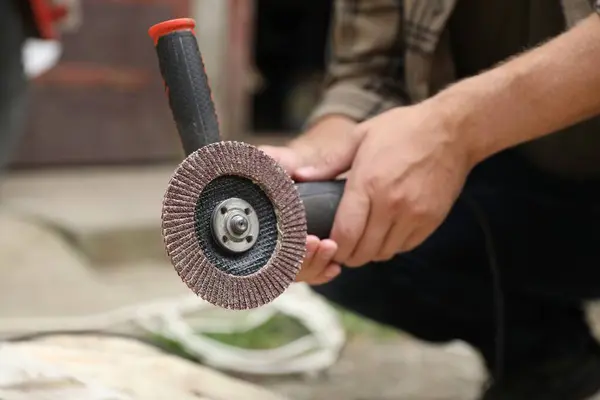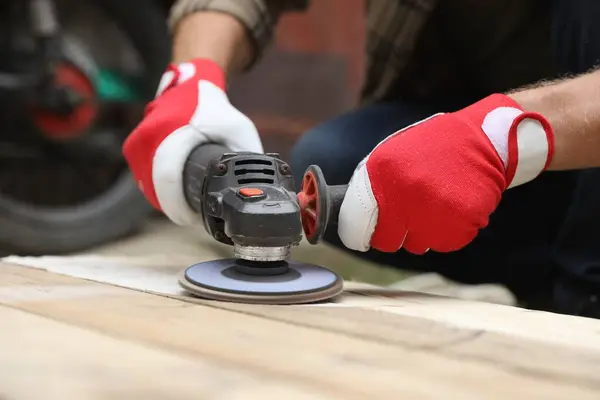Woodworking is a craft that demands precision and attention to detail. One of the most crucial steps in this process is achieving a smooth, flawless finish on the wood surface. While many tools and techniques are available for this purpose, flap discs have emerged as a versatile and effective option for woodworkers seeking to refine their projects. In this article, we’ll delve into how flap discs can be used to achieve smooth wood finishes, the benefits they offer, and tips for their effective use.
Understanding Flap Discs
Flap discs are abrasive tools designed with overlapping pieces of abrasive material, known as flaps, adhered to a sturdy backing plate. These flaps are made from a range of abrasive materials, including zirconia alumina, ceramic, and aluminum oxide. As the disc rotates, the flaps wear down gradually, exposing fresh abrasive material and providing a consistent cutting or sanding action. This makes flap discs highly efficient for both stock removal and finishing tasks.
Originally developed for metalworking, flap discs have found a place in woodworking due to their ability to blend, grind, and finish wood surfaces with precision. Their design allows for a smoother finish compared to traditional grinding discs, making them ideal for applications where surface quality is paramount.
Benefits of Using Flap Discs for Wood Finishing
Versatility: Flap discs are available in various grit sizes, from coarse to fine, allowing woodworkers to choose the appropriate disc for the specific task at hand. Coarser grits are excellent for initial shaping and material removal, while finer grits are perfect for smoothing and finishing.
- Consistency: The overlapping flap design ensures a consistent sanding action, minimizing the risk of gouging or uneven surface textures. This is particularly important in woodworking, where even small imperfections can detract from the final product’s appearance.
- Ease of Use:Flap discs are easy to use, even for those new to woodworking. They are typically mounted on angle grinders, which are common tools in most workshops. Their design allows for a smooth, controlled sanding process, reducing the learning curve associated with more specialized tools.
- Efficiency:The ability of flap discs to perform multiple functions—such as shaping, smoothing, and finishing—reduces the need for tool changes, saving time and increasing productivity. This efficiency is particularly beneficial in professional woodworking environments where time is money.
- Durability:Flap discs are designed to last longer than traditional sandpaper, thanks to their self-sharpening properties. As the flaps wear down, fresh abrasive material is exposed, ensuring a consistent sanding action over a longer period. This durability translates to cost savings, as fewer discs are needed to complete a project.
Types of Flap Discs for Wood Finishing
Flap discs are available in different types, each suited for specific tasks in the wood finishing process. Understanding the differences between these types will help you choose the right disc for your project.
- Zirconia Flap Discs: These discs are known for their durability and are ideal for heavy-duty tasks, such as removing large amounts of material or working with hardwoods. Zirconia is a tough abrasive that maintains its sharpness over time, making it a good choice for aggressive sanding or grinding.
- Ceramic Flap Discs: Ceramic flap discs are designed for maximum performance and longevity. They are often used for finishing work, where a smooth surface is essential. Ceramic abrasives stay sharp longer and cut cooler than other materials, reducing the risk of burning or damaging the wood.
- Aluminum Oxide Flap Discs:Aluminum oxide is a versatile abrasive suitable for general-purpose sanding. These discs are ideal for lighter finishing tasks, where a fine, smooth surface is required. They are also cost-effective, making them a popular choice for hobbyists and professionals alike.
- Non-Woven Flap Discs: These discs are made from a non-woven, synthetic material impregnated with abrasive particles. They are designed for fine finishing and polishing tasks, where the goal is to achieve a high-gloss finish or prepare the wood for staining or varnishing.
How to Achieve Smooth Wood Finishes with Flap Discs
Achieving a smooth wood finish with flap discs requires the right technique and a careful approach. Here’s a step-by-step guide to help you get the best results:
- Choose the Right Grit:Begin with a coarse grit flap disc (e.g., 40 or 60 grit) if you need to remove a lot of material or smooth out rough surfaces. Gradually progress to finer grits (e.g., 80, 120, or higher) as you move closer to the final finish. The key is to remove scratches left by the previous grit, resulting in a progressively smoother surface.
- Set the Correct Speed: When using an angle grinder with a flap disc, setting the right speed is crucial. Higher speeds can lead to excessive heat buildup, which can burn the wood or cause the disc to wear out prematurely. Lower speeds are recommended for finishing tasks, as they allow for better control and reduce the risk of damaging the wood.
- Maintain a Steady Hand: Keep the angle grinder steady and move it in smooth, even strokes across the wood surface. Applying too much pressure can cause gouging, while too little pressure may not achieve the desired level of smoothing. Let the flap disc do the work, and avoid forcing it into the wood.
- Work in Sections: For larger surfaces, work in small sections to ensure even sanding. Overlapping your passes slightly will help blend the sections together, resulting in a uniform finish. Pay special attention to edges and corners, where it’s easy to miss spots or apply uneven pressure.
- Inspect Your Work: After completing each pass with a flap disc, inspect the wood surface for any remaining imperfections. If necessary, switch to a finer grit and repeat the process until you achieve the desired smoothness.
- Finish with a Non-Woven Disc: For the final finishing touches, consider using a non-woven flap disc to polish the wood surface. This type of disc is excellent for removing any remaining fine scratches and preparing the wood for staining, varnishing, or painting.
Safety Considerations
When working with flap discs, safety should always be a top priority. Here are some essential safety tips to keep in mind:
- Wear Protective Gear:Always wear safety goggles, a dust mask, and hearing protection when using an angle grinder with a flap disc. Wood dust and debris can be hazardous to your health, and the noise generated by the grinder can cause hearing damage over time.
- Secure the Wood: Ensure that the wood piece is securely clamped or held in place before starting your work. This will prevent it from moving or shifting during the sanding process, reducing the risk of accidents.
- Check the Disc: Inspect the flap disc for any signs of damage or wear before use. A damaged disc can shatter during operation, posing a serious safety risk. Replace any discs that show signs of excessive wear or damage.
- Use the Correct Angle: Keep the angle grinder at a slight angle (about 15-30 degrees) to the wood surface while sanding. This ensures that the flap disc makes full contact with the wood and reduces the risk of gouging or uneven sanding.
- Avoid Overheating:Excessive heat can damage both the wood and the flap disc. If you notice the wood getting hot, reduce the pressure, lower the speed, or take a break to allow the material to cool down.
Applications Beyond Wood Finishing
While flap discs are excellent for achieving smooth wood finishes, their versatility extends to other applications in woodworking. They can be used for:
- Shaping and Contouring:Flap discs are effective for shaping and contouring wood pieces, allowing you to create curves and complex shapes with precision.
- Removing Old Finishes: When refurbishing furniture or wooden structures, flap discs can quickly remove old paint, varnish, or stain, preparing the surface for a new finish.
- Blending and Feathering: Flap discs are ideal for blending edges and seams, especially in woodworking projects where multiple pieces of wood are joined together. They help create a seamless transition between surfaces.
Conclusion
Flap discs are a powerful and versatile tool for achieving smooth wood finishes in woodworking. Their ability to perform multiple functions—such as material removal, smoothing, and finishing—makes them an essential addition to any woodworker’s toolkit. By choosing the right type of flap disc, following proper techniques, and adhering to safety guidelines, you can achieve professional-quality results in your woodworking projects.
Whether you’re a seasoned woodworker or a hobbyist, flap discs offer an efficient and effective way to refine your wood surfaces and bring your creations to life. As with any tool, practice and experience will enhance your skills, allowing you to make the most of this versatile abrasive tool in your woodworking endeavors.


